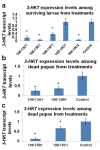Development of an RNAi based microalgal larvicide to control mosquitoes
- PMID: 38860035
- PMCID: PMC11164250
- DOI: 10.5281/zenodo.10894766
Development of an RNAi based microalgal larvicide to control mosquitoes
Conflict of interest statement
Competing interests: No competing interests declared.
Figures




Similar articles
-
Identification of larvicide-resistant catch basins from three years of larvicide trials in a suburb of chicago, IL.Environ Health Insights. 2014 Oct 13;8(Suppl 2):1-7. doi: 10.4137/EHI.S16014. eCollection 2014. Environ Health Insights. 2014. PMID: 25392699 Free PMC article. Review.
-
Demonstration of RNAi Yeast Insecticide Activity in Semi-Field Larvicide and Attractive Targeted Sugar Bait Trials Conducted on Aedes and Culex Mosquitoes.Insects. 2023 Dec 15;14(12):950. doi: 10.3390/insects14120950. Insects. 2023. PMID: 38132622 Free PMC article.
-
Community acceptance of yeast interfering RNA larvicide technology for control of Aedes mosquitoes in Trinidad.PLoS One. 2020 Aug 14;15(8):e0237675. doi: 10.1371/journal.pone.0237675. eCollection 2020. PLoS One. 2020. PMID: 32797066 Free PMC article.
-
Comparison between diflubenzuron and a Bacillus thuringiensis israelensis- and Lysinibacillus sphaericus-based formulation for the control of mosquito larvae in urban catch basins in Switzerland.J Am Mosq Control Assoc. 2013 Jun;29(2):138-45. doi: 10.2987/12-6301R.1. J Am Mosq Control Assoc. 2013. PMID: 23923328
-
RNA Interference for Mosquito and Mosquito-Borne Disease Control.Insects. 2017 Jan 5;8(1):4. doi: 10.3390/insects8010004. Insects. 2017. PMID: 28067782 Free PMC article. Review.
Cited by
-
RNA Interference in Insects: Protecting Beneficials and Controlling Pests.Front Physiol. 2019 Jan 11;9:1912. doi: 10.3389/fphys.2018.01912. eCollection 2018. Front Physiol. 2019. PMID: 30687124 Free PMC article. Review.
-
Use of micro and macroalgae extracts for the control of vector mosquitoes.PeerJ. 2023 Oct 9;11:e16187. doi: 10.7717/peerj.16187. eCollection 2023. PeerJ. 2023. PMID: 37842039 Free PMC article. Review.
-
RNAi by Soaking Aedes aegypti Pupae in dsRNA.Insects. 2021 Jul 13;12(7):634. doi: 10.3390/insects12070634. Insects. 2021. PMID: 34357293 Free PMC article.
-
Toward invasive mussel genetic biocontrol: Approaches, challenges, and perspectives.iScience. 2023 Sep 28;26(10):108027. doi: 10.1016/j.isci.2023.108027. eCollection 2023 Oct 20. iScience. 2023. PMID: 37860763 Free PMC article. Review.
-
Mosquito gene targeted RNAi studies for vector control.Funct Integr Genomics. 2023 May 25;23(2):180. doi: 10.1007/s10142-023-01072-6. Funct Integr Genomics. 2023. PMID: 37227504 Free PMC article. Review.
References
-
- World Health Organization: World Malaria Report. 2011.
-
- Chandrahas RK, Rajagopalan PK: Observations on mosquito breeding and the natural parasitism of larvae by a fungus Coelomomyces and a mermithid nematode Romanomermis in paddy fields in Pondicherry. Indian J. Med. Res. 1979;69:63–67. - PubMed
-
- Nam VS, Yen NT, Holynska M, Reid JW et al. National progress in dengue vector control in Vietnam: survey for Mesocyclops (Copepoda), Micronecta (Corixidae), and fish as biological control agents. Am. J. Trop. Med. Hyg. 2000;62:5–10. - PubMed
-
- Poopathi S, Tyagi BK: The challenge of mosquito control strategies: from Primordial to Molecular Approaches. BMBR. 2006;1:51–65.
LinkOut - more resources
Full Text Sources
Other Literature Sources
